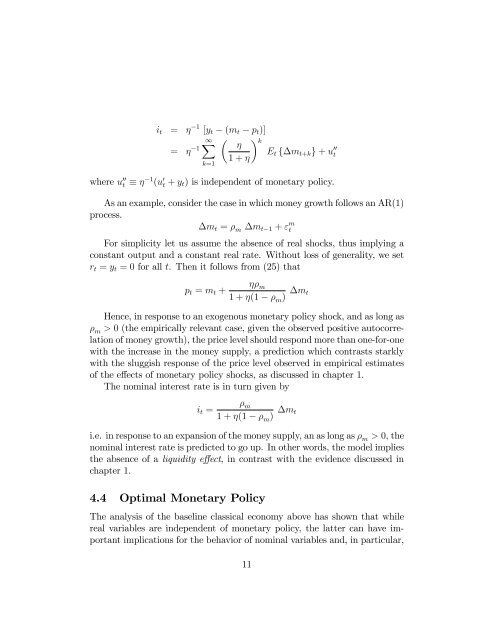Monetary Policy, Inflation, and the Business Cycle Chapter 2 A ...
Monetary Policy, Inflation, and the Business Cycle Chapter 2 A ...
Monetary Policy, Inflation, and the Business Cycle Chapter 2 A ...
You also want an ePaper? Increase the reach of your titles
YUMPU automatically turns print PDFs into web optimized ePapers that Google loves.
i t = 1 [y t (m t p t )]<br />
X 1 k <br />
= 1 E t fm t+k g + u 00<br />
t<br />
1 + <br />
k=1<br />
where u 00<br />
t 1 (u 0 t + y t ) is independent of monetary policy.<br />
As an example, consider <strong>the</strong> case in which money growth follows an AR(1)<br />
process.<br />
m t = m m t 1 + " m t<br />
For simplicity let us assume <strong>the</strong> absence of real shocks, thus implying a<br />
constant output <strong>and</strong> a constant real rate. Without loss of generality, we set<br />
r t = y t = 0 for all t. Then it follows from (25) that<br />
p t = m t +<br />
m<br />
1 + (1 m ) m t<br />
Hence, in response to an exogenous monetary policy shock, <strong>and</strong> as long as<br />
m > 0 (<strong>the</strong> empirically relevant case, given <strong>the</strong> observed positive autocorrelation<br />
of money growth), <strong>the</strong> price level should respond more than one-for-one<br />
with <strong>the</strong> increase in <strong>the</strong> money supply, a prediction which contrasts starkly<br />
with <strong>the</strong> sluggish response of <strong>the</strong> price level observed in empirical estimates<br />
of <strong>the</strong> e¤ects of monetary policy shocks, as discussed in chapter 1.<br />
The nominal interest rate is in turn given by<br />
i t =<br />
m<br />
1 + (1 m ) m t<br />
i.e. in response to an expansion of <strong>the</strong> money supply, an as long as m > 0, <strong>the</strong><br />
nominal interest rate is predicted to go up. In o<strong>the</strong>r words, <strong>the</strong> model implies<br />
<strong>the</strong> absence of a liquidity e¤ect, in contrast with <strong>the</strong> evidence discussed in<br />
chapter 1.<br />
4.4 Optimal <strong>Monetary</strong> <strong>Policy</strong><br />
The analysis of <strong>the</strong> baseline classical economy above has shown that while<br />
real variables are independent of monetary policy, <strong>the</strong> latter can have important<br />
implications for <strong>the</strong> behavior of nominal variables <strong>and</strong>, in particular,<br />
11
















